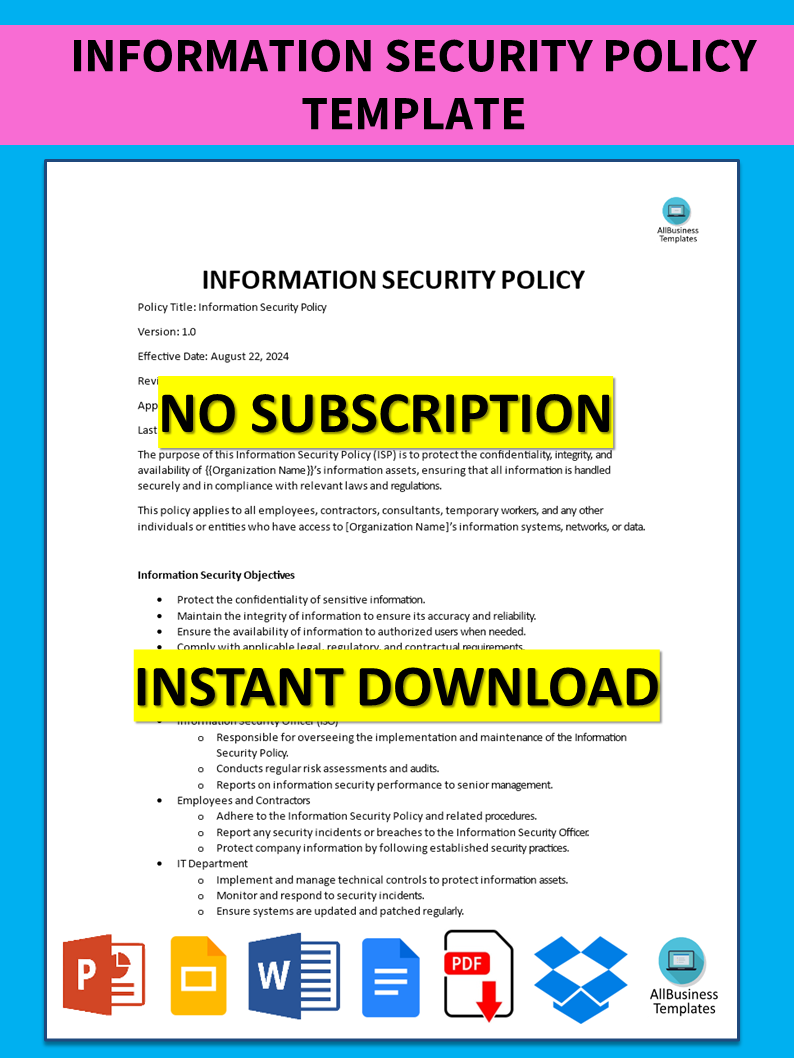Information Security Policy Template

Speichern, ausfüllen, drucken, fertig!
You are searching for a template for information security policy? What is a template for an information security policy? Download this sample template now and use it according to your needs.
Verfügbare Gratis-Dateiformate:
.docx- Dieses Dokument wurde von einem Professional zertifiziert
- 100% anpassbar
You are searching for a template for information security policy? What is a template for an information security policy? We have provided a free customizable template based on individual organization’s requirements including, access control, encryption, and data handling amongst others.
A predesigned framework called an information security policy template aids companies in establishing an all-inclusive and productive information security policy. The reason is that this policy gives the regulations, recommendations, and behaviors that an organization has to take to shield its information sources from hazards like illicit entry, data breaches, and cyber assaults. The plan gives a structured method for developing a personalized information security policy that meets all the individual needs of an organization along with its statutory obligations.
The policy templates for information security contain vital components as enlisted below:
- Introduction:
- Purpose: A short explanation about why this policy was made concerning protecting the information assets of the organization.
- Scope: Specifies who will be subjected to such policy (e.g., every employee, every contractor, or even third parties involved).
- Objectives Of Information Security: In terms of confidentiality keeping sensitive information accessible only to those people who are allowed access to it. For instance, integrity involves ensuring the correctness and dependability of data while availability means ensuring that people are permitted to obtain information whenever they want it.
- Roles And Responsibilities:
- Management: Senior management’s role in supporting and enforcing the policy through procedures as well as informal practices lies mostly within their realm of authority
- Employees: Their main obligation includes safeguarding these assets across various platforms
- IT Security Team: Involvement carries out specific roles in ensuring enforcement of security measures as well as continual surveillance of them.
- Information Classification:
- Data Classification Levels: Guidelines for categorizing information based on its sensitivity levels (such as public, internal secret up till highly classified).
- Handling Procedures: Directions on how handling should occur at every level in addition to storage space for that category of files and processes used when exchanging them with other individuals or organizations.
- Access Control:
- User Access Management: The policies for granting, reviewing, and revoking access to information systems.
- Authentication: Guidelines on password use, multi-factor authentication, and other access control mechanisms.
- Authorization: Procedures for ensuring that access privileges are by the user’s role.
- Physical Security:
- Facility Access Controls: Measures for securing the physical access to buildings, data centers and offices.
- Equipment Security: Guidelines for the physical protection of hardware like computers and servers.
- Network Security:
- Firewall and Antivirus Use: Requirements for using firewalls, antivirus software and other network protection tools.
- Secure communication: Policies for encrypting data in transit as well as secure communications over the internet.
- Remote Access: Guidelines on accessing the organization’s network from remote locations securely
- Incident Response:
- Incident Reporting: Procedures to report security incidents or breaches.
- Response Plan: Steps to take in response to a security incident including containment, eradication, and recovery.
- Communication Protocols: Guidelines on how to communicate incidents with stakeholders including legal authorities if necessary.
- Data Protection
- Backup Procedures: Regular data backups and safekeeping actions.
- Data Encryption: Policies for encrypting sensitive data while resting or in motion.
- Data Retention and Disposal: Procedures on how long data should be retained as well as disposing of it when no longer needed securely.
- Training and Awareness
- Employee Training: Prerequisites of periodic training on the best practices of information security.
- Awareness Programs: Projects aimed at informing employees about dangers posed by security so that they can remain alert.
- Compliance
- Legal and Regulatory Requirements: Making certain that said policy meets requisite laws and regulations (like GDPR or HIPAA).
- Internal Audits: Regular audits to determine compliance with the policy as well as zones of enhancement.
- Policy Review and Updates
- Review Cycle: Schedule for systematic review processes alongside updates for the various policies
- Amendment Procedures: Process through which changes are made to these policies whenever necessary
- Policy Enforcement:
- Disciplinary Actions: Consequences for breaking the information security policy
- Monitoring and Auditing: Ongoing monitoring to ensure policy compliance and detect potential threats regarding safety.
Importance of template for Information Security Policy:
- Guidance: Offers a coherent and orderly direction for creating a customized information protection decree.
- Consistency: Makes sure that every component in data safety is uniformly addressed throughout the entity.
- Compliance: Aids firms to attain legislative obligations, regulatory requirements, and industry norms regarding data protection.
- Risk Mitigation: Minimizes unsafe occurring by formulating precise instructions and ways of doing things.
- Employee Accountability: Discernment between purposes of different workers involved in their organizations’ data safeguard roles.
By employing a template for information security policies, major security concerns are tackled, and there is assurance that the policy is thorough, understandable and efficient in conserving the organization’s information resources.
To make your work better, just hit the button “Open with Google Docs” or get our sample information Security Policy Template in a Word template format right now! Your success at formulating an efficient and properly structured plan is within reach.
HAFTUNGSAUSSCHLUSS
Nichts auf dieser Website gilt als Rechtsberatung und kein Mandatsverhältnis wird hergestellt.
Wenn Sie Fragen oder Anmerkungen haben, können Sie sie gerne unten veröffentlichen.
